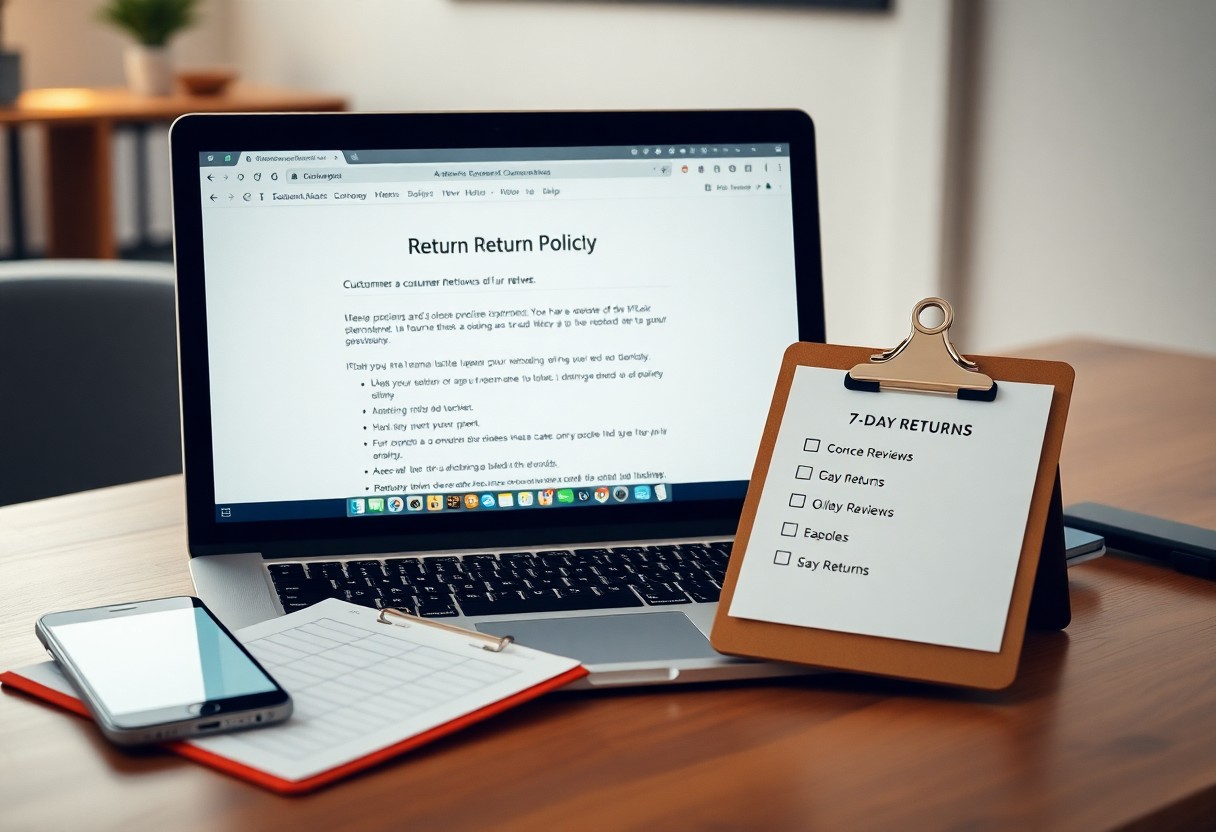Days can significantly impact your shopping experience, especially when it comes to understanding a 7-day return policy. You have a limited window to evaluate your purchases, making it crucial to know the specifics of the policy. If you decide to return an item, it must be done within this timeframe to receive a refund or exchange. Take note of any conditions that apply, such as original packaging or tags, to avoid losing your money. By being informed, you can navigate the return process effectively and protect your interests.
The Fundamentals of a 7-Day Return Policy
Key Features of a 7-Day Return Policy
A 7-day return policy provides a structured timeframe for you to evaluate your purchases. This brief period encourages quick decision-making and ensures that items remain in excellent condition. After receiving your order, you typically have a specific window to return goods that do not meet your expectations, which minimizes the risk of loss for retailers.
Among the main features you should be aware of are:
- Timeframe: You have a strict 7-day window from the date of receipt.
- Condition Requirements: Items must be returned in their original packaging and condition.
- Refund Method: You can expect a full refund or store credit based on your choice.
- Exclusions: Certain items, like perishables or personalized goods, may be exempt.
- Return Process: Instructions for returning items must be clear and accessible.
Thou should keep these key features in mind as they directly affect your satisfaction and ensure a smoother return process.
Comparison with Other Return Timelines
Analyzing various return policies helps put the 7-day timeframe into perspective. Common timelines among retailers vary significantly, influencing your purchasing decisions. Some retailers offer 30-day or even 90-day return policies, which provide greater flexibility but can lead to indecision regarding returns.
| Return Policy Duration | Typical Benefits |
|---|---|
| 7 Days | Quick decision-making, less wear on products. |
| 30 Days | More time for evaluation and potential use. |
| 90 Days | Maximum flexibility, encourages deliberate purchasing. |
A 7-day return policy frequently encourages swift action on your part, whereas a longer timeline fosters hesitance. Each policy serves specific consumer behavior, where the balance of convenience and responsibility shifts significantly depending on the timeframe.
The Impact on Consumer Confidence
How a 7-Day Window Influences Purchase Decisions
The availability of a 7-day return window allows you to make purchasing decisions with less hesitation. You’re empowered to assess your purchase fully, knowing you have the opportunity to return it if it doesn’t meet your expectations. This limited timeframe can trigger a sense of urgency, prompting quicker decisions which in turn may lead to increased sales for retailers. Retailers like Amazon and Zappos have effectively utilized similar policies to enhance consumer satisfaction and loyalty.
In sectors like electronics or apparel, the ability to test products within a week reinforces your confidence. A survey by the National Retail Federation indicated that 67% of consumers feel more secure buying a product when a clear return policy is in place. This sense of security can drive you to explore new brands or products, ultimately broadening your shopping horizons.
The Role of Trust in Retail Relationships
Trust is a vital component in establishing long-term relationships between you and retailers. A 7-day return policy signifies that the retailer values your experience and stands behind their products. You’re more likely to return to a brand that demonstrates reliability through transparent return practices. Research shows that companies with robust return policies often report higher customer retention rates.
Retailers who emphasize trust can create a cycle of positive interactions, where you feel valued and supported. This trust often extends beyond the return window itself, impacting your overall shopping experience and leading to word-of-mouth referrals. Retailers like Nordstrom thrive on this principle, fostering customer loyalty through quality service and fair return practices.

Navigating Common Misconceptions
Debunking Myths: Are 7 Days Enough?
You may wonder if a 7-day return policy provides sufficient time to evaluate a purchase. Many people believe that this short window leads to rushed decisions and dissatisfaction. However, reality often differs. Retailers implement this timeframe precisely to encourage timely feedback, which can lead to faster resolution of issues. Most customers tend to know within the first few days if a product meets their expectations, thus making the 7-day window a reasonable frame for returns.
Additionally, studies show that many online shoppers appreciate clear, concise return policies. Sites such as Zappos and Amazon exemplify successful management of return policies, allowing customers to make informed choices without overthinking them. You should challenge the common belief that these policies are too restrictive; they often motivate you to choose wisely without dragging the process out.
Reality Check: What Happens After the 7 Days?
After the 7-day mark, your options may become limited, but that doesn’t mean you’re entirely out of luck. Many retailers offer exchanges or store credit even after the return window closes. Policies can vary significantly, so checking the fine print is crucial. If an item is faulty or not as described, many stores adhere to consumer protection laws, which may allow for returns beyond the standard timeframe.
Some companies provide a grace period for certain items, especially those on sale or clearance. In such cases, reaching out directly to customer service can yield positive results, as they may consider your situation on a case-by-case basis. Ensuring you document any communication and have your receipt handy can enhance your chances of receiving favorable outcomes.
Overall, becoming familiar with a retailer’s terms can significantly influence your post-purchase options. Even navigating beyond a strict 7-day policy can lead to satisfactory resolutions when you proactively engage with customer service about your concerns or needs. Be ready to articulate your case, and you may find that many companies are more accommodating than their policies suggest.
Strategic Implementation for Retailers
Best Practices for Crafting a 7-Day Return Policy
Your 7-day return policy should be clear and easily accessible to consumers, ensuring they understand the terms without ambiguity. Begin by explicitly stating which items are eligible for return, as some products like personalized items or perishable goods may not fall under your return policy. Incorporating a straightforward, step-by-step process for initiating returns will enhance customer trust, facilitating a smoother experience. Include vital details such as the point of contact for return inquiries and necessary packaging guidelines, as this transparency can significantly reduce confusion.
Offering incentives can also enhance your policy’s effectiveness. Consider providing a store credit option alongside refunds, which encourages customers to shop again without losing their loyalty. You might also implement a return shipping fee that is clearly stated upfront, allowing customers to weigh their options without hidden costs surfacing later. By actively engaging your customers with an approachable return process, you not only mitigate dissatisfaction but also foster long-term loyalty.
Monitoring and Adjusting the Policy for Success
After establishing your 7-day return policy, continuous monitoring is vital to gauge its impact on your sales and customer satisfaction. Utilize feedback tools like surveys and reviews to collect customer insights and identify patterns in returns. Analyzing data such as return reasons can provide valuable context. For instance, if a significant number of returns are attributed to sizing issues, it may be time to revise your size guides or product descriptions to better align with customer expectations.
Data-driven adjustments keep your return policy relevant and effective. Tracking metrics like return frequency and the net promoter score (NPS) can guide decision-making. If customers frequently return items, consider stock changes based on inventory turnover trends. Regular evaluations not only ensure alignment with customer needs but also demonstrate your commitment to their satisfaction.
Implementing proactive monitoring techniques strengthens your policy’s performance. Set up regular reviews based on data analytics and customer feedback, assessing how policies affect repeat purchases and overall business health. Identifying trends over time allows you to make informed decisions about necessary adjustments, enhancing both customer experience and business outcomes.

Customer Experience and Satisfaction
Providing a streamlined return experience significantly enhances customer satisfaction. You’ll find that customers appreciate a transparent, hassle-free process, which directly impacts their perception of your brand. For example, a survey conducted by Invesp indicates that 92% of customers are more likely to shop with brands that offer easy returns. When you implement a clear and user-friendly return policy, it not only reduces anxiety but also encourages repeat purchases, as customers feel secure in their buying decisions.
Enhancing Customer Loyalty Through Simplified Returns
Returning items can often be a frustrating aspect of online shopping, leading to hesitation in future purchases. By simplifying the return process, you create a positive experience that cultivates trust and loyalty. A study by Forrester Research found that 63% of consumers consider the returns process an important factor in their loyalty to a brand. Offering multiple methods for returns, such as in-store options or prepaid shipping labels, ensures convenience and elevates brand loyalty, making customers more inclined to choose your store over competitors.
The Psychological Benefits of Easy Return Processes
An easy return process not only alleviates post-purchase dissonance but also fosters a sense of control for consumers. When you provide a clear and straightforward return policy, customers feel empowered in their decisions. A Harvard Business Review article noted that consumers who feel assured about their return options are likely to spend 30% more on subsequent purchases. This comfort level encourages the exploration of more products, knowing they can return if the items don’t meet expectations.
Further, the psychological impact of easy returns extends beyond initial purchases. Customers often experience less stress and anxiety when they know they can easily return an item without significant barriers. The perception of risk diminishes, which can turn a one-time buyer into a loyal repeat customer. By investing in a seamless return experience, you not only cater to immediate customer needs but also build long-term relationships and a dependable brand reputation.
To wrap up
As a reminder, your understanding of the 7-day return policy is vital for a smooth shopping experience. This policy allows you to evaluate your purchase and ensure it meets your expectations. If you find that an item does not satisfy your needs, you have a limited window to return it for a refund or exchange, so familiarize yourself with any specific conditions or requirements outlined in the policy.
By adhering to the 7-day timeframe, you can minimize potential complications with returns. It is important to keep your receipts and any original packaging, as these may be necessary to process your return efficiently. Engaging with customer service promptly can also aid in resolving any issues related to your return, enhancing your overall satisfaction with your purchase.
FAQ
Q: What is the return policy duration?
A: The return policy allows for returns within a period of 7 days from the date of purchase.
Q: Are there any conditions for returning items?
A: Yes, items must be unused, in their original packaging, and accompanied by the receipt or proof of purchase for a return to be accepted.
Q: How will I receive my refund after returning an item?
A: Refunds will be processed to the original payment method used during the purchase within 3-5 business days after the returned item is received and inspected.